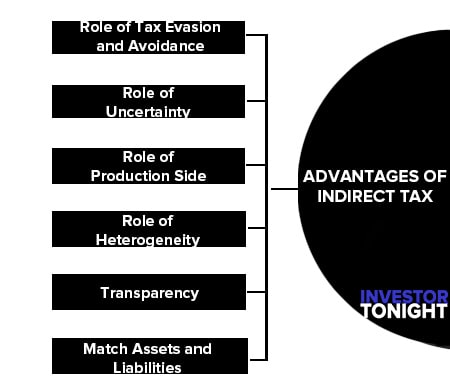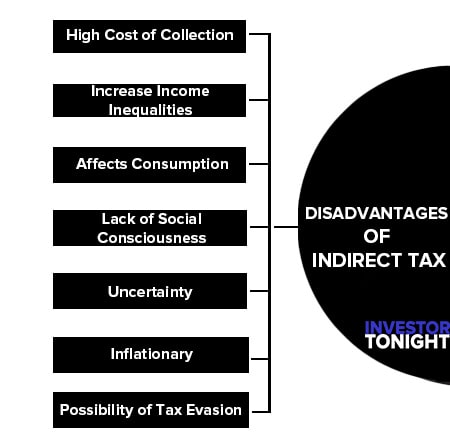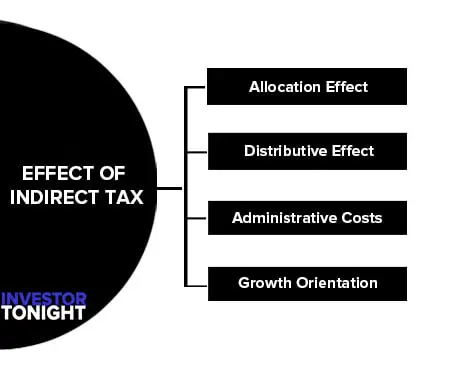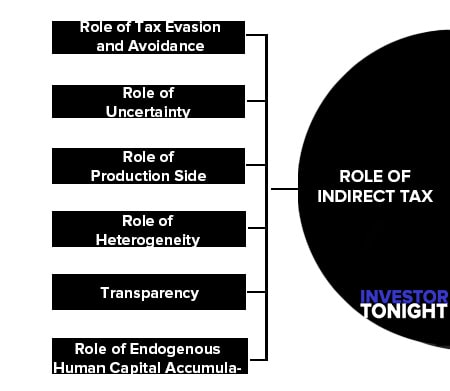What is Indirect Taxes?
An indirect tax is one in which the burden can be shifted to others. The taxpayer is not the tax bearer. The impact and incidence of indirect taxes are on different persons. An indirect tax is levied on and collected from a person who manages to pass it on to some other person or persons on whom the real burden of the tax falls. For e.g. commodity taxes or sales tax, excise duty, customs duties, etc. are indirect taxes.
Table of Contents
The most important single fact about indirect taxes in developing economies is the dominant role that they play in the revenue system of almost every country. Particularly, indirect taxes are an important element in stabilization tax packages that aim at raising revenue in the short run.
Advantages of Indirect Tax
The advantages of indirect taxes are briefly explained as follows:
- Convenient
- Difficult to Evade
- Wide Coverage
- Elastic
- Universality
- Social Welfare
- Flexibility and Buoyancy
- May not Affect Motivation to Work

Convenient
Indirect taxes are imposed on the production, sale and movement of goods and services. These are imposed on manufacturers, sellers and traders, but their burden may be shifted to consumers of goods and services who are the final taxpayers.
Such taxes, in the form of higher prices, are paid only on the purchase of a commodity or the enjoyment of a service. So taxpayers do not feel the burden of these taxes. Besides, the money burden of indirect taxes is not completely felt since the tax amount is actually hidden in the price of the commodity bought.
They are also convenient because generally they are paid in small amounts and at intervals and are not in one lump sum. They are convenient from the point of view of the government also since the tax amount is collected generally as a lump sum from manufacturers or traders.
Difficult to Evade
Indirect taxes have in-built safeguards against tax evasion. The indirect taxes are paid by customers, and the sellers have to collect them and remit them to the Government. In the case of many products, the selling price is inclusive of indirect taxes. Therefore, the customer has no option to evade the indirect taxes.
Wide Coverage
Unlike direct taxes, indirect taxes have wide coverage. The majority of the products or services are subject to indirect taxes. The consumers or users of such products and services have to pay them.
Elastic
Some of the indirect taxes are elastic in nature. When government feels it is necessary to increase its revenues, it increases these taxes. In times of prosperity, indirect taxes produce huge revenues to the government.
Universality
Indirect taxes are paid by all classes of people and so they are broad-based. Poor people may be out of the net of the income tax, but they pay indirect taxes while buying goods.
Indirect taxes promote social welfare. The amount collected by way of taxes is utilized by the government for social welfare activities, including education, health and family welfare. Secondly, very high taxes are imposed on the consumption of harmful products such as alcoholic products, tobacco products, and other products.
So it is not only to check their consumption but also enables the state to collect substantial revenue in this manner.
Flexibility and Buoyancy
The indirect taxes are more flexible and buoyant. Flexibility is the ability of the tax system to generate proportionately higher tax revenue with a change in the tax base, and buoyancy is a wider concept, as it involves the ability of the tax system to generate proportionately higher tax revenue with a change in the tax base, as well as tax rates.
May not Affect Motivation to Work
The indirect taxes may not affect the motivation to work and to save. Since most of the indirect taxes are not progressive in nature, individuals may not mind paying them. In other words, indirect taxes are generally regressive in nature. Therefore, individuals would not be demotivated to work and to save, which may increase investment.
Disadvantages of Indirect Tax
Although indirect taxes have become quite popular in both developed and underdeveloped countries alike, they suffer from various disadvantages of indirect tax, which the following are:
- High Cost of Collection
- Increase Income Inequalities
- Affects Consumption
- Lack of Social Consciousness
- Uncertainty
- Inflationary
- Possibility of Tax Evasion

High Cost of Collection
Indirect tax fails to satisfy the principle of economy. The government has to set up elaborate machinery to administer indirect taxes. Therefore, the cost of tax collection per unit of revenue raised is generally higher in the case of most indirect taxes.
Increase Income Inequalities
Generally, indirect taxes are regressive in nature. The rich and the poor have to pay the same rate of indirect taxes on certain commodities of mass consumption. This may further increase income disparities among the rich and the poor.
Affects Consumption
Indirect taxes affect the consumption of certain products. For instance, a high rate of duty on certain products such as consumer durables may restrict the use of such products. Consumers belonging to the middle-class group may delay their purchases, or they may not buy at all.
The reduction in consumption affects investment and production activities, which in turn hampers economic growth.
Indirect taxes do not create any social consciousness as the taxpayers do not feel the burden of the taxes they pay.
Uncertainty
Indirect taxes are often rather uncertain. Taxes on commodities with elastic demand are particularly uncertain since the quantity demanded will greatly affect as prices go up due to the imposition of tax. In fact, a higher rate of tax on a particular commodity may not bring in more revenue.
Inflationary
The indirect taxes are inflationary in nature. The tax charged on goods and services increase their prices. Therefore, to reduce inflationary pressure, the government may reduce the tax rates, especially, on essential items.
Possibility of Tax Evasion
There is a possibility of evasion of indirect taxes as some customers may not pay indirect taxes with the support of sellers. For instance, individuals may purchase items without a bill, and therefore, may not pay Sales tax or VAT (Value Added Tax), or may obtain the services without a bill, and therefore, may evade the service tax.
Difference between Direct and Indirect Taxes
Direct Tax: Those taxes whose burden cannot be shifted to others and the person who pays these to the government has to bear it are called direct taxes. In other words, a direct tax is imposed on an individual or a group of individuals, which affects them directly i.e, which they have to pay to the government directly. A direct tax can be of different types: Income Tax, Wealth Tax and Gift Tax.
Indirect Taxes: An indirect tax is levied on and collected from a person who manages to pass it on to some other person or persons on whom the real burden of the tax falls. For e.g. commodity taxes or sales tax, excise duty, customs duties, etc. are indirect taxes.
Difference between Direct and Indirect Taxes
| Direct Taxes | Indirect Taxes |
| Payer of tax and sufferer of tax one and same (i.e. impact and incidence on the same person). | Payer of tax is not a sufferer of tax whereas sufferer of tax is not paying directly to the Government (i.e. impact on one head and incidence on other head). |
| Income-based taxes. | Transaction based taxes. |
| The rate of taxes is different from person to person. | The rate of duties is not different from person to person. |
| Entire revenue goes to the Central Government of India. | Revenue source to Central Government of India as well as State Governments. |
| The Central Board of Direct Taxes (CBDT) is an important part of the Department of Revenue, Ministry of Finance (India). It plays a vital role in planning & implementing direct taxes policy in India. It also monitors direct taxes law followed by Income Tax Departments. | The Central Board of Excise and Customs (CBE&C) is an important part of the Department of Revenue, Ministry of Finance (India). It plays a vital role in planning & implementing indirect taxes policy in India. It also monitors indirect taxes law followed by Excise and Customs Departments. |
Effect of Indirect Tax
The 16th Amendment forever changed the tax code and paved the way for the passage of a wide assortment of indirect taxes that affect virtually every aspect of modern life. While it may seem like mere semantics when looking at the definitions of direct and indirect taxes.
The fact is that government revenues increased greatly after the adoption of the 16th Amendment and the income taxes it helped to legalize:

Allocation Effect
The allocative effects of direct taxes are superior to those of indirect taxes. When a particular amount is raised through a direct tax like income tax, it would imply a lesser burden than the same amount raised through an indirect tax like excise duty.
An indirect tax involves an excessive burden as it distorts the consumer’s preference regarding goods due to price changes. Thus an indirect tax has an adverse effect on the allocation of resources than a direct tax.
Distributive Effect
Direct taxes are progressive and they help to reduce inequalities. But indirect taxes are regressive and they widen the gap of inequalities. Hence, direct taxes are regarded to be superior to indirect taxes in effecting a more equitable distribution of income and wealth.
But this is not always true. Even indirect taxes can be made progressive by levying them on luxuries and exempting them on necessaries. Both direct and indirect taxes are alternative methods of achieving any particular redistribution of income.
Administrative Costs
The administrative costs of direct taxes are more than that of indirect taxes. Direct taxes are narrow-based and have many exemptions. Indirect taxes can be conveniently collected and the cost of collection is constant over time. Indirect taxes are easier to administer than direct taxes.
From point of view of efficiency and productivity, indirect taxes are better. Indirect taxes are wrapped up in prices and hence they cannot be easily evaded. They are more productive as their cost of collection is the least. Thus, from point of view of administrative costs, indirect taxes are relatively superior.
Growth Orientation
Indirect taxes are more growth-oriented than direct taxes. Direct taxes, being progressive, reduce savings. When savings and investments are discouraged, economic growth is adversely affected. Indirect taxes discourage consumption and increase savings.
Indirect taxes on luxuries reduce conspicuous consumption and channelise resources into growth-oriented programmes.
Role of Indirect Tax
The Atkinson-Stiglitz theorem: The starting point in the optimal tax literature is the well-known Atkinson-Stiglitz (1976) theorem which states that when the government may choose a general income tax function, individuals differ only on wage-earning ability, and the utility functions are separable between labour and all commodities, then no indirect taxes need be employed.
This theorem implied as Atkinson-Stiglitz (1976) noted, that the extent to which indirect taxes are employed may depend on the (more complex) form of consumer preferences and possibly on restrictions on the type of income taxation that can be employed; for example, horizontal equity considerations can introduce constraints on the structure of income taxes.
The costs of tax administration are not recognized either; allowing for cost differences for separate taxes could also affect the optimal tax structure. The Atkinson-Stiglitz theorem shaped the research agenda on optimal tax structures for many years to come.
But, it is important to note that Atkinson-Stiglitz (1976) saw their analysis as being more useful in shaping the structure of the argument regarding the choice of optimal tax structure than in providing policy advice.
What followed Atkinson-Stiglitz’s work has been a series of important papers showing how indirect taxes may be justified in an optimal tax structure if some of the explicit and also implicit assumptions in their work are relaxed.
These are role of indirect tax based on atkinson-stiglitz theorem explained in details:
- Role of Tax Evasion and Avoidance
- Role of Uncertainty
- Role of Production Side
- Role of Heterogeneity
- Transparency
- Role of Endogenous Human Capital Accumulation

Role of Tax Evasion and Avoidance
It turns out that considering the administration of taxes, in particular enforcement and evasion issues have important consequences for the optimal tax mix of direct and indirect taxes. Boadway, Marchand and Pestieau (1994) show that if different taxes have different evasion characteristics, some optimal tax structure with a meaningful role for indirect taxes emerges naturally.
Assuming that only income tax can be evaded (or can be evaded more easily)10 the authors analyze the case for supplementing optimal (non-linear) income taxation with commodity taxation and develop conditions under which commodity taxation should not be at the same rate.
Role of Uncertainty
Cremer and Gahvari (1995) show that in the presence of uncertainty, where otherwise identical individuals are uncertain about the wage they would earn, differential commodity taxation is a necessary component of an optimal tax structure.
Role of Production Side
Naito (1999) shows that, even when the government is using a Pareto-efficient non-linear income tax system under weak separability of workers’ utility functions, imposing a non-uniform commodity tax can improve welfare, once the assumption of constant marginal cost of production is abandoned and the production side of the economy is explicitly introduced in the analysis.
Role of Heterogeneity
Cremer, Pestieau and Rochet (2001) show that when individuals differ in several unobservable characteristics (productivity and endowments), differential commodity taxes do have a role to play as instruments of optimal tax policy – an optimal (general) income tax will not suffice.
While the optimal commodity tax rates follow traditional Ramsey rules. Papers by Saez (2002) and Balestrino, Cigno, and Pettini (2003) make contributions along similar lines.
Transparency
Dahlby (2003) argues that levying both direct and indirect consumption taxes could improve the transparency of the tax system, especially when there are several tiers of government with autonomous taxing powers.
Role of Endogenous Human Capital Accumulation
Naito (2004) finds that using a commodity tax can increase social welfare in the presence of a nonlinear income tax system when human capital accumulation is endogenous. In particular, assuming that individuals with greater ability have comparative advantage in accumulating skilled human capital.
Naito shows that indirect redistribution such as imposing a tariff on unskilled human capital intensive goods can increase the efficiency of, and complement, an income tax system.
Read More Articles